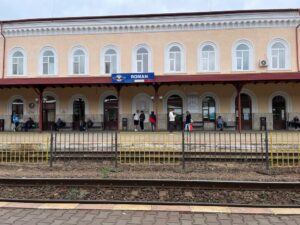
Citizenship by descent comes with a personal history, one belonging to each of our client. Our client from today didn’t have any birth certificate from his deceased mother, who was born in a city in Neamt county, Roman.
Our team member submitted a request to the civil service in Roman city, Neam county and traveled to retrieve the original.
Our team traveled to the local authorities of Roman civil state office, which were very helpful to research into the State Archives dated 1949 and issue a duplicate of our client’s mother birth certificate which we will use it for our client’s citizenship by descent. We posted in this blog some photos from Roman city.
According to the official census of 1930, the total number of Jewish in Romania was 756,930.
In the 20th century, the fascism and anti-Semitism of a significant part of the elite between the two world wars favored the Holocaust in Romania so that following the transition of the Basarabian Jews to Soviet citizenship, the mass emigration to Palestine (after 1948, Israel) and following the crimes committed by the anti-Nazi regimes in Romania (including Basarabia and Transnistria) and Horthyst in Northern Transylvania, this minority numbered only 146,264 people in 1956.
Transnistria) and Horthyst in Northern Transylvania, this minority numbered only 146,264 people in 1956.
During the Stalinist period of the communist regime, the manifestation of the Mosaic religion and culture or of belonging to international Jewry was considered, according to the official ideology, as “bourgeois nationalism” and “cosmopolitanism”, which is retrospectively considered as the “hidden anti-Semitism” of the regime; in all cases, this situation led to the emigration of the majority of Romanian Jews to the Western countries or to Israel, so that in the 2011 census only 3,271 Jews were registered in Romania.

When Roman I Musat, lord of Moldavia between 1391-1394, founded the city of Roman, Jews were among the first inhabitants. Roman I released the Jews from military service in exchange for a tax.
In 1740 there were Jewish communities in the cities of Roman, Bacău and Galați. The 1899 census shows that Israelites made up 19% of Romania’s urban population and 38% of the urban population of Moldavia.
After World War II the exodus of Jews to Israel (to a lesser extent to the West) led to their almost total disappearance in Romania: in 1945 there were 410,000 Jews, and in 1961 225,000 Jews.
A significant part of Israel’s Jewish population originates from Romania and the Republic of Moldova, or are descendants of emigrants from these countries. Jews in Romanian countries have maintained links with the Land of Israel for centuries. Religious Jews who were able, left in their old age to die and be buried in the Holy Land. Jewish communities in Romania helped these Jews economically, living in poverty in the four cities considered holy, where Jewish communities had existed for thousands of years: Jerusalem, Hebron, Tiberias and Safed.
During the Second World War, a second wave of emigrants left Romania under the auspices of the Jewish society “Aliyah” (led by Șmuel Leibovici and Eugen Meissner) during the time of the Antonescian persecution and immediately after the coup d’état of 23 August 1944. The Jews who left at that time had to leave all their belongings and money behind, and travelled under wartime conditions, some perishing in the attempt (the case of the “Struma”, torpedoed by a Soviet submarine, resulting in the death of all passengers and crew, over 700 people, drowned in the Black Sea, except for one passenger).
Around 60,000 Jews left Romania during the Anti-Nazi period and after 23 August 1944 another 120,000, although many were unable to enter Palestine because the British authorities, in order to increase relations with the Arab world, considered them ‘citizens of an enemy country’ and opposed Jewish immigration anyway. After many difficulties, most ended up in Israel, and some in the United States and France.
The third and final wave of emigrants occurred in the decade 1945-1955, under the communist regime, when some 166,400 Romanian Jews settled in Israel. They too had to abandon their property and pay (or have Israel pay for them) taxes commensurate with their level of education, which was generally high.
The departure of the Jews took place in two stages, the first, between 1954 and 1955, in which the elderly, invalids and those without higher education were allowed to leave, and the second, after 1958, characterized by departures in small groups, with interruptions. The expatriation forms were filled in at the regional militia headquarters, after waiting in long queues, and the result, often negative, came after 6-12 months. The immediate reaction after submitting the papers was expulsion from schools and universities, in staged meetings to expose and vilify enemies of the people. Intellectuals were sent “to work at the bottom”, i.e. unskilled labour, and their names were removed from published works – those that could not be indexed.
The lucky ones who received approval for departure – which could be cancelled at random, at any time before boarding the plane – had a few days to clear their possessions and prepare the 35 kg. of luggage – only used items, excluding art objects, precious metals, except for a wedding ring, paintings and photographs, etc. Those “in the field” were allowed 70 kg. of luggage. The documents that had to be presented for departure included the renunciation of Romanian citizenship for a very high fee (departure was made on the basis of a “Certificate of Travel” for persons without citizenship), the certificate of retrocession of all scholarships, stipends, tax exemptions throughout the period of study and a few dozen other certificates stamped that they were no longer in debt to all cooperatives, grocery stores, libraries, etc. in the locality.
Source: https://ro.wikipedia.org/wiki/Istoria_evreilor_din_Rom%C3%A2nia
Our team retrieves all the identification documents of the ancestors of our clients from authorities in Romania, Basarabia, Ukraine or Belarussia, in order to prepare the file for obtaining Romanian citizenship by descent.

